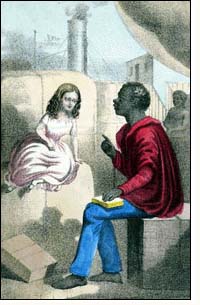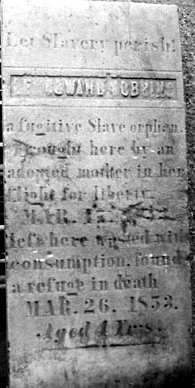Oberlin Anti-Slavery Collection
 The Anti-Slavery Collection at Oberlin College Library is a nationally significant collection of value to researchers of American anti-slavery movements as well as the history of Oberlin. The Anti-Slavery Collection consists of around 2500 printed titles (many are multi-volume) most of which have been cataloged and so can be searched using the online catalog.
The Anti-Slavery Collection at Oberlin College Library is a nationally significant collection of value to researchers of American anti-slavery movements as well as the history of Oberlin. The Anti-Slavery Collection consists of around 2500 printed titles (many are multi-volume) most of which have been cataloged and so can be searched using the online catalog.
Contents include: Anti-slavery societies' documents such as annual reports, addresses, and publications; books, pamphlets, and other documents outlining the moral, religious, economic, and legal aspects of the slavery debate. There are travelers' observations of slavery; slave narratives - autobiographical, biographical, and fictional; and biographies of leaders of the anti-slavery movement. There are numerous newspapers and periodicals, including The Abolitionist, The American Anti-Slavery Reporter, The Emancipator and Republican, The Gerrit Smith Banner, The Liberator, Liberty, and many others. There are political works, including documents related to the Missouri Compromise, the Fugitive Slave Law, the Kansas-Nebraska Controversy, party propaganda, and speeches made in and out of Congress. There are books for children; poetry, songs, anthologies, and gift books. There is some pro-slavery literature as well. The collection includes ephemera, including manuscript bills of sale for slaves, manumission papers, and artifacts such as slave shackles.
History of the Collection | Inventory | Additional Resources
History of the Collection
Founded in 1833, Oberlin's early supporters, students, and settlers actively pursued the Christian ideals of figures like Charles Grandison Finney and William Lloyd Garrison. Oberlin College was the first co-educational institution in the United States, as well as the most influential of the early institutions that admitted African-Americans. The town was major stop on the Underground Railroad. Oberlin College has, and continues to embrace many social and political causes, and the foremost among these was the crusade to end slavery in the United States.
During the years 1838-1840, travelers to England made financial appeals to British anti-slavery sentiment and also collected books for the school's fledgling library. Their trip was marvelously successful, and among the 2000 or so volumes they brought back with them were several British books arguing against slavery. This now represents the earliest acquired portion of our Anti-Slavery Collection.
When Oberlin's first library building, Spear Library, was set to open in 1885, librarian Rev. Henry Matson - recognizing the role which Oberlin had played in the abolitionist struggle - made an appeal to local residents for anti-slavery literature:
"It is proposed to make in the college library an anti-slavery collection, complete as possible, for the future historian, in which shall be gathered every book, every pamphlet, every report, every tract, every newspaper, and every private letter on the subject. For such a collection nothing is unimportant. Scattered here and there these documents are all but worthless, but gathered in one collection they would be priceless." (Oberlin Weekly News, Feb. 29, 1884)
Among the contributions made at this time, most notably by the heirs of William Goodell, was the original draft of the Anti-Slavery Declaration of 1833 in the handwriting of William Lloyd Garrison and some objects related to slavery and the Civil War.
Inventory
No complete inventory other than our online catalog is used for the bulk of the book, pamphlet, and periodical records in the Anti-Slavery Collection. Author, title, and keyword searches restricted to "Main Special Collections" are recommended.
Anti-Slavery Collection Manuscript and Ephemera Inventory -- list of some of the uncataloged items in Special Collections
DIGITAL SCANS of many of the items from Oberlin's Anti-Slavery Collection are openly accessible at the Internet Archive. This collection was created from the microfiche set: Oberlin College Library Anti-Slavery Collection
Gravestone of Lee Howard Dobbins
One of the most compelling artifacts in Special Collections is a gravestone of a four year old escaped slave. In March of 1853, a slave woman named Miriam arrived in Oberlin from Kentucky, with her entire family—her children and grandchildren and a sickly four-year-old foster child named Lee Howard Dobbins. Miriam had fled her master in a desperate attempt to save her daughters, whom she had learned were going to be sold.
By the time they arrived in Oberlin, little Lee Howard was extremely ill. Miriam and the rest of her family couldn't afford to wait for his convalescence — since she and her family were the only slaves their master owned, he was no doubt in hot and angry pursuit. A family in Oberlin promised to care for the child, and Miriam and her children were safely delivered to Canada, where her brother was awaiting them.
Lee Howard Dobbins died of consumption a week later. The whole town mourned his death - a thousand people were reportedly crammed into First Church for his funeral, where all grieved not only the loss of this child, but the horrors of slavery. A collection at the funeral was used to buy this gravestone for him.
The stone has weathered badly, and so it was put in the Oberlin College Library Special Collections for safekeeping in 1938. The Inscription reads:
Let slavery perish!
LEE HOWARD DOBBINS
a fugitive Slave orphan. brought here by an adopted mother in her flight for liberty MAR. 17, 1853 left here wasted with consumption, found a refuge in death MAR. 26, 1853 Aged 4 Years
Additional Resources
Among the rather extensive mid-nineteenth century documents held by the Oberlin College Archives are papers relating to persons at Oberlin College and contain information related to the anti-slavery movement and African-American education. Some of these papers were formally considered of a piece with the Oberlin Anti-Slavery Collection.
Samuel J. May Anti-Slavery Collection at Cornell University.
Yale Slavery and Abolition Portal